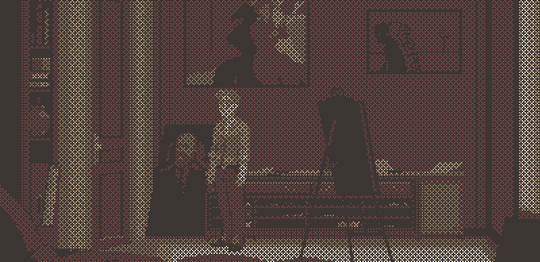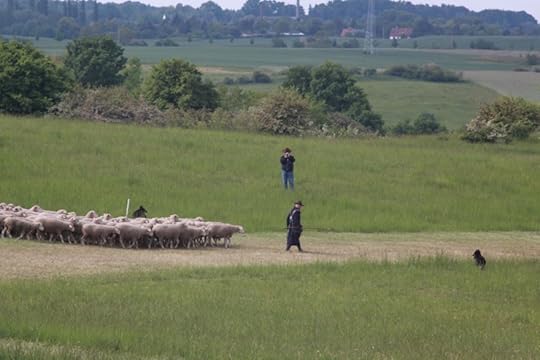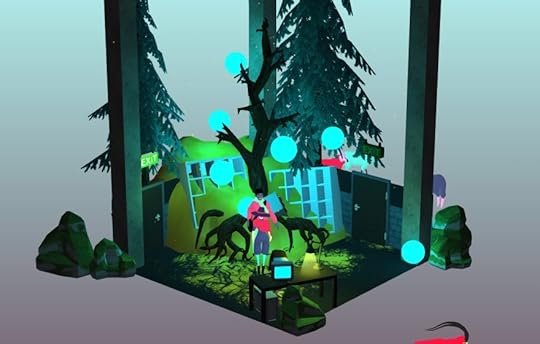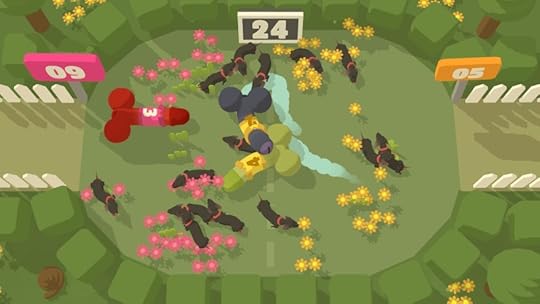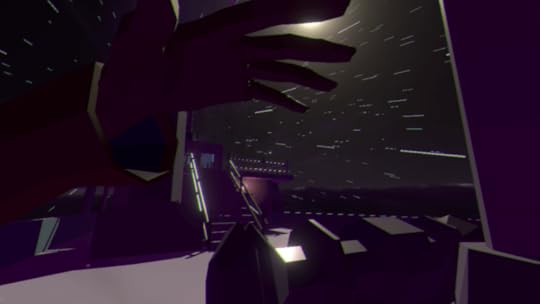Kill Screen Magazine's Blog, page 27
November 21, 2016
Uncover the hidden psyche of Vienna’s elite in The Lion’s Song: Episode 2
The second episode of the point-and-click game series The Lion’s Song is now available to purchase and download on Steam. It’s a doozy, letting you dive into the imagined fears of real historical figures that were part of Vienna’s artistic elite at the turn of the 20th century.
You play as an aspiring painter called Franz Markert who is desperate to gain recognition for his work. He does this by using his talent to strip people (sometimes literally) of their flaws and emotions that they try to hide and then bring that to the canvas. However, while doing so, Markert also has to battle his own “mental demons”—self-doubt for the most part—that hold him back. Your role is to question his subjects in a way that exposes their psyche so that Markert can paint the most vulnerable and powerful pictures of these people.
If you don’t know, The Lion’s Song is a story of four parts, each of which follow an exceptional creative mind of early 20th-century Austria. The first part took place in an isolated cabin among the Austrian Alps, where a young composer struggled to find inspiration for an upcoming concert. The series is about the creative struggle of exceptional artists who must find inspiration and human connections to succeed.
paint the most vulnerable and powerful pictures
Outside of that, the creators of the series at Mipumi Games hope to increase the complexity of its project with each new entry. “We listened to our fans and put a lot of love and effort into offering various branching paths, making sure the game offers even more surprises and different playthroughs,” said Gregor Eigner of Mipuni. “You will even see your choices changing the game world if you jump back into previously played episodes.”
That last point is something we touched on previously regarding this second entry in The Lion’s Song. In short, the pictures that you paint in Episode 2 might appear on the walls of the cabin in Episode 1. The connection here is that Markert, the painter in Episode 2, actually painted the protagonist of Episode 1 before she took her sabbatical to the Alps—she even muses on him at one point in the episode. This interconnectedness seems to be a decision motivated by the “Connected Worlds” theme of the game jam the original prototype of The Lion’s Song was made for.
If you want to get a taste for The Lion’s Song then you can download Episode 1 for free on Steam. If that satisfies and you want more, you can purchase Episode 2 for $3.99, or you can buy the Season Pass for $9.99.
The post Uncover the hidden psyche of Vienna’s elite in The Lion’s Song: Episode 2 appeared first on Kill Screen.
Solitude wants to help you escape the hell of media
“Being ‘only’ a designer in highly political or economically difficult times feels weird,” Jana Reinhardt, one half of the German game-making team Rat King Entertainment, told me. She feels frustrated and desperate as the world changes in volatile ways around her, and all she can do is design stuff in response. To deal with this, she developed an escapist fantasy, one that involved becoming a shepherd.
That might seem odd, especially given the fact that Reinhardt is aware that being a shepherd is hardly an easy time: “I know it’s pretty hard work, no vacations and also no animal cuteness, as you sell the lambs off for much-too-low prices for butchering,” she said. But the shepherding fantasy that persists in Reinhardt’s mind is separated from the known reality. This is due to the impression of the occupation that she has subscribed to, supplied to her by a couple of specific sources.
“There is also a new progressive generation who wants to be more open”
One of the origins of the fantasy is the popular Twitter account @herdyshepherd1, which is the personal feed of a British shepherd who often posts idyllic photos while on the job. Seeing this Twitter account also triggered Reinhardt’s fond memories of a shepherd family that lived in her home village. She combined the two to create a compelling alternate reality, exchanging her home office in the middle of the city that she was stuck in for several hours every day, for the bucolic landscapes a shepherd works in and around.
Photo courtesy of Jana Reinhardt’s Tumblr blog
After six years of living in the city, Reinhardt and her programming partner Friedrich Hanisch—the other half of Rat King—moved to Halle in the southern part of Germany. By this time, Reinhardt wanted to make a game based on her shepherding fantasy, and Halle proved to be a good place to feed that desire. “Germany only has two shepherding schools and one of them is coincidentally in Halle,” she told me. “The contests are full of old men. Don’t get me wrong, they are friendly, easy to talk to, but also a bit grumpy/suspicious/elitist—of course you have to prove yourself to be taken serious[ly].”
The game that Reinhardt started making had one of these grumpy old men as its main character as she wanted Halle to directly influence her project. Then, as she spent more time around the local shepherds, she made a new discovery by way of the shepherd’s apprentices. “There is also a new progressive generation who wants to be more open and has a more modern approach [to shepherding],” Reindhardt said. “I met a class full of girls at the event and one of the annual winners was also a girl. That’s why I changed the shepherd character from an old grumpy man to a girl. Which made a lot more sense, because the whole game was supposed to be a personal work.”
At this point, the game Reinhardt was making could have been a “shepherd simulator” or a “romantic walking sim,” but as she worked on it more she realized it wasn’t this that she was most interested in. It was the symbol of “guiding” or “being on your own” that the shepherd embodied that had drawn Reinhardt to the occupation. With this realization, Reinhardt was able to make shepherding more of a metaphor in her game, and it’s this approach that defines the final version of the game.
Called Solitude, Reinhardt’s game has you leave a drab office environment to escape to the countryside. But you don’t do it alone. You take a number of people with you, “social weirdos” according to Reinhardt, and help them to also escape the boring loop of their lives as office workers. You do this by helping them out of paperwork tornadoes, digging them out from the rubble of office equipment, and my favorite, which has you clip trees that have binders for leaves and burn them to comfort a woman shivering with anxiety. Every time you help a person out, they follow you into the next room, turning into a sheep or ram with the transition.
people who need someone to guide them in order to better their lives
While the metaphor of people turning into sheep could be seen as a critique of how easily they’re influenced (as typified by the term “sheeple”), Reinhardt’s intentions are clearly to encourage the idea of helping to guide people out of oppression and towards liberation; people who need someone to guide them in order to better their lives. Being a shepherd, then, realizes her desire to be able to do more in the current political climate than her role as a designer has allowed her. She wants to help people out but is limited in her capacity to do that by both her job and the fact that she is only one person.
Solitude is Reinhardt’s fantasy brought to life—the main character escapes an office to help others move away from the media that harasses their thoughts, and to leave the loneliness that worsened their condition. With any luck, either Reinhardt or someone who plays her game, can turn that fantasy into a reality.
You can purchase Solitude for $2 over on itch.io. You can also read its development blog (if you can read German).
The post Solitude wants to help you escape the hell of media appeared first on Kill Screen.
Kids use Club Penguin to protest against the president-elect
As an American college student, I’m no stranger to protests. In the past month, I’ve attended roughly two or three per week regarding issues like health care, systematic racism, discrimination against undocumented students, and most recently, our president-elect.
After the election on November 8th, protests immediately began appearing all over the country. In Boston, thousands took to the street the very next day. Going out to march in crowds filled with signs saying things like “not my president” and “I’m with her” is one way to exercise freedom of speech and express dissatisfaction, but not always the safest. With these gatherings escalating and causing property damage, and arrests being made with the use of pepper spray, political protests aren’t exactly family-friendly events.
Club Penguin users have shown us that there’s more than one way to protest
However, Club Penguin users have shown us that there’s more than one way to protest. The site was created in 2005 as a virtual world where kids can play games and interact with one another. In days following the election, flocks of penguins gathered online to voice their opposition to Trump. Many of the statements typed in the online protest were the same as the ones chanted on the street, though others had some alterations; penguins were spotted saying “my penguin, my choice” and “penguins of color matter.” While some find these social justice penguins nothing more than amusing, the site allowed children, who have a huge stake in political matters despite their inability to vote, to engage in political speech in a relatively safe space that is designed specifically for them. They are able to experiment with political thought with people their own age, and they can feel like their voices and ideas are just as valid as anyone else’s.
In this way, Club Penguin serves as an example of how virtual worlds and MMOs can function as accessible mediums for political discourse. In reality, street protests aren’t for everyone. One person might have a physical disability that prevents them from marching for miles, and another may have a mental health issues that prevents them from joining large, loud crowds. As mentioned earlier, such spaces are not always ideal for children either. Beyond that, many people simply aren’t comfortable with the dangers associated with protesting. Virtual worlds that allow large numbers of players to interact with each other, like World of Warcraft (2004), Guild Wars (2005), and of course Club Penguin, are spaces that allow communities to engage in relevant political dialogue without the physical risks and stresses of a street protest.
I'M AT THE CLUB PENGUIN TRUMP PROTEST pic.twitter.com/qhgHQuJYR6
— carla (@ridleydaisy) November 14, 2016
If kids can stage an organized political act on Club Penguin, then similar acts could be staged in different virtual worlds. While social media like Twitter and Facebook might be more common and sometimes reach a wider audience when used to broadcast political sentiments, there is still great significance to be found in what’s happening on Club Penguin. This unique form of protest has accomplished what most protests hope to do: gain national attention. Buzzfeed, hugely popular, wrote a piece about it, and NPR published a more formal article about it three days later.
But the significance is also in how Club Penguin members function as a community. Not all the penguins online are Clinton supporters, meaning that this political act is an opportunity to spark discussion between members. People frequently make friends online through gaming, doing things like going on raids together, or in this instance, playing minigames. MMOs aren’t just for entertainment; they provide personal connections as well, meaning that political statements in these communities can have a personal impact. Much like a protest against economic injustice outside my dorm pushes me to re-examine my beliefs and discuss them with my peers, a protest in an online community exposes those users to the beliefs and real-world experiences of people all over the world that they play alongside in a virtual space.
a new take on what online activism can look like
Of course, this is not to say that MMOs are the ideal medium for political discourse. By nature, they do offer physical safety, or at least the absence of physical danger, to their users. However, they are not all as hyper-accessible as Club Penguin, which allows anyone with an email address to participate. Hefty membership fees like those charged for World of Warcraft make some of these virtual spaces economically inaccessible for a lot of folks, and hate speech runs rampant in these spaces as well. Club Penguin has the benefit of being designed for kids, thus preventing a lot of vulgar and discriminatory language from being circulated in-game.
Despite some barriers to political dialogue in online spaces, these virtual penguins have offered us a new take on what online activism can look like.
///
The post Kids use Club Penguin to protest against the president-elect appeared first on Kill Screen.
Visual Out asks you to embrace the glitches of a dying computer
“They deserted us. You’re all that’s left.”
These are the words that echo through Visual Out, a Metroid-like platformer set inside the guts of a broken down, dying computer. Created by Ohio-based game maker MadameBerry, Visual Out has you play as an escaped program tasked with exploring different sections of the machine in hopes of finding out the secrets of your creator’s demise.
As the program, you can gain unique abilities and upgrades that will aide in exploration. You can manipulate the environment around you by controlling the flow of power, and roam around a mix of mechanical and digital landscapes, rendered with distinctive visual effects and simple pixel art.
exploring different sections of the machine
According to the itch.io page, the game began as an entry for Ludum Dare 31 where the theme was “Entire Game on One Screen.” After receiving positive feedback and re-designing the entry without the Ludum Dare requirements, MadameBerry began to reboot the project as a full game. In November 2015, a demo was released, although it’s out of date and still pre-alpha according to the website.
Patreon is being used to fund the game, with supporters able to access in-progress builds or help commission custom music and add extra features like more areas or abilities to uncover and unlock. Visual Out was also recently greenlit for Steam.
For more information on Visual Out, click here.
The post Visual Out asks you to embrace the glitches of a dying computer appeared first on Kill Screen.
November 17, 2016
Genital Jousting is now available for some stiff competition
It’s time to make some dicks look silly. Yep, Genital Jousting has arrived on Steam Early Access today. It’s an online and local multiplayer game about penetrating your friends, and yes, it’s as crude as that sounds.
Everybody plays as a creature made of male genitalia in this game: a flaccid penis, a pair of inflated testicles, and an anus. You score a point in each round for either being penetrated—another player inserting their penis into your anus—or penetrating someone else. If you manage both in a single round then you get two points. It’s a game about achieving orgiastic connections. “If this is something that makes you uncomfortable or sounds unappealing, please do not purchase or play Genital Jousting,” warns Free Lives, the South African team behind the game.
Fluids fly, anuses squelch
The current version of the game has three different game modes. If you have no one else around to play with then you can jump into the online lobby and find games with strangers. Otherwise, there’s the Traditional mode, which puts up to eight players (with a minimum of three) on the same machine in a bare arena where they do battle by way of sloppy intercourse. Fluids fly, anuses squelch, and everyone hopefully has a good time—note that to join the game everyone has to “Hold up to consent.”
The Party mode is also for people playing on a single PC, but gives you five rounds to compete in, with each being a different randomized game. You might have to spray more of your team’s color of jizz around an arena to win, or you might be racing through a field of cacti (yes, ouch), flying to the big anus planet in the sky, or tasked with rounding up wiener dogs (i.e. dachshunds). The range of games available so far make great use of our inherent sensitivities around dicks to create unease, surprise, and slippin’ slidin’ fun.
Of course, this being Early Access, there’s potential here for more games too, some that may further push our boundaries of what we think acceptable. But, for now, the team is focusing on “listening to whatever reviews there are and trying to fix whatever problems we’ve created,” according to Evan Greenwood, one of the creators at Free Lives.
videogames aren’t ready for vaginas yet
It’s also interesting to note that Genital Jousting‘s arrival on Steam Early Access comes only a couple of days after a controversy involving a vagina in a videogame. Specifically, it was the recently released Watch Dogs 2, which has some character models expose their fully-modeled vaginas. One PlayStation 4 player took a picture of one of these vaginas and shared it. Doing this earned him a temporary ban from Sony while the team at Ubisoft that made the game removed that virtual woman’s genitalia from it.
Of note here is that Ubisoft has removed the explicit depiction of a vagina from the game while there are male characters who walk about with their dicks out that remain untouched in the game. When we spoke to Greenwood earlier this year about Genital Jousting and its portrayal of male genitalia he said something that is relevant now more than ever. “Making penises abject and silly works well because masculinity is so often portrayed as powerful and successful,” he said. “That same joke doesn’t translate perfectly to vaginas.”
The Watch Dogs 2 controversy seems to prove Greenwood’s instincts are right—videogames aren’t ready for vaginas yet. But dicks? As long as they’re flaccid it seems they can be fully exposed without too much panic. Hell, in Genital Jousting you can dress them up in bow ties and create an ouroboros entirely out of dicks and anuses.
You can purchase Genital Jousting on Steam Early Access. Find out more about it on its website.
The post Genital Jousting is now available for some stiff competition appeared first on Kill Screen.
Carl Burton’s first videogame reveals the surreal secrets of the city
Airport luggage gallops, potted trees ride escalators, and soda cans cyclone in Carl Burton’s first videogame ISLANDS, released today for PC and iOS. It’s a “surreal trip through the mundane,” concerned with those transitory urban locations that lie between destinations.
Its subtitle, “Non-Places,” is taken from Marc Augé’s book, Non-Places: An Introduction to Supermodernity (2009). “In the prologue, there is a description of someone traveling, moving through these kinds of liminal spaces,” Burton said. “They’re everywhere, but feel curiously isolating and neutral.” This might be a town square or a waiting room; places that serve no meaningful purpose other than to be endured as part of a larger journey.
It’s these places that Burton recreates with his signature art style—each scene shades of a single color, a heavy mist hanging over it all—which is intended to blur the edges between objects, to create an effect “that’s more atmospheric and less grounded.” This can be seen in his many GIFs, which he has been commissioned to produce for The New York Times, Serial, Colossal, and Medium. He decided to transform these curious, looping images into a videogame comprised of 10 individual scenes for a simple reason: to see how interactivity would affect the ideas he likes to explore.
a grotesque meshing of tree and machine
He knew from the start that he wanted the interaction to be simple enough for anyone to play, but for it to “lead the player through something more surreal and idiosyncratic” than you might get in a casual game. What he came up with works: they’re not puzzles, more like a guided sequence of inputs that take you through an evolving state of a single location. “I wanted the confusion to feel more light and realistic, like when you’re staying at a friend’s house and you have to figure out how to use their shower,” Burton told me.
In one of my favorite scenes, an ordinary public fountain malfunctions, triggering its repair mode, which has you clicking on its embellishments to raise the fountain from the ground, revealing a huge biomechanical vertical column underneath it; a grotesque meshing of tree and machine. Each scene follows a similarly unexpected reveal, where you input a sequence to uncover hidden ecosystems—as if magically awakening a creature beneath the city or the mall.

Burton chose the locations he used by rebuilding them from a hazy memory of walking around cities. “They all blur together as a remembered experience, all the malls and airports and ATMs,” he said. He relied on spontaneity to move him from one scene to the next, never knowing what he was going to come up with until he was doing it. But when he had decided, he made sure to carefully plan the space and how it changed with interacting, putting together a choreography of concrete and plastic.
seeing these pedestrian spaces as a kind of secret machine
As the visuals are deliberately semi-vague, what really helps with not only giving these places a grounding in reality but also prompting players to look for buttons to press are the sounds. Burton only used freely licensed sounds he found and modified online, but due to the influence of field recordings and BBC wildlife sound recordist Chris Watson, his audio work proves very effective—a convincing emulation of the urban real. That said, he does also make lamps buzz and fans beep, which doesn’t come across as weird as it sounds at the time. The game lures you into seeing these pedestrian spaces as a kind of secret machine, as if they all had a second function engineered into them, like a car made for James Bond that has taillights that flip to reveal missile launchers.
You leave ISLANDS with new eyes. Walk around the city or town and you may start to see small orbs of function, synchronized ornaments, patterns that suggest hidden machine parts. That possibility is at least a welcome break from the paranoia we’re driven to at most other times. Rather than a government spy hiding in our postbox there might be a mossy machine-beast ready to be unlocked.
You can purchase ISLANDS: Non-Places on Steam, itch.io, the Humble Store, and the App Store. Find out more about it on its website.

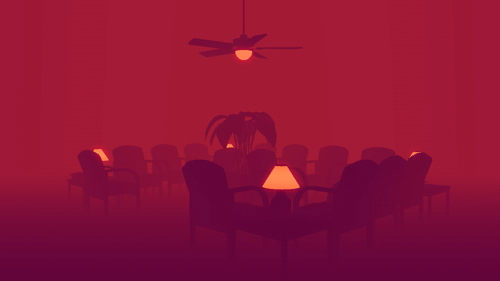
The post Carl Burton’s first videogame reveals the surreal secrets of the city appeared first on Kill Screen.
Tyranny is an RPG about being properly evil
Sign up to receive each week’s Playlist e-mail here!
Also check out our full, interactive Playlist section.
Tyranny (Windows, Mac)
BY OBSIDIAN ENTERTAINMENT
The alternative title for Tyranny is, presumably, “50 Shades of Evil.” It’s an isometric RPG in the traditional style that takes place in a world where evil has won. It doesn’t want you to quell this evil, instead, it wants you to enforce its rule, and asks you to indulge in your sadism. Mostly, it does this through the choices it asks you to make: Will you smother a baby? Commit the mass murder of innocents? Throw a prisoner out of a very high tower to make a point? The wicked genius of Tyranny is how it makes those options both devastating and satisfying. It’s best to leave your morals at the door for this one. Oh, and good news: if you’re the type of person who wants to focus on story and skip combat, Tyranny does have a Story Mode to provide that kind of experience.
Perfect for: Donald Trump, actual demons, sadists
Playtime: 12-20 hours
The post Tyranny is an RPG about being properly evil appeared first on Kill Screen.
November 16, 2016
Ambient Mixtape 16 is a superb collection of eerie games
Ah, it’s so good when this happens. What am I on about? Oh, you know, nine independent game makers decided to get together and make a game each, then package them all under the title Ambient Mixtape 16.
The idea was for all of them to use the same tools and format—a First Person Camera controller made by Alex Harvey for Unity3D—and to see how their individual styles interpreted the theme “After Hours.” For the most part these are mood pieces, focusing on broadcasting a sense of unease, often using a choppy or distorted visual effect with killer sound effects and eerie music.
All of the games are available to download for free, with the option to donate money to any of them if you wish, so it’s best if you explore them by yourself. But I can’t help but offer some of my own impressions of them if you wanna carry on reading. Oh, and I’ll say now, I couldn’t get Lycaon’s game THE HOUSE THAT DRIPPED BLOOD to work on my machine, so unfortunately I don’t know how that one is (I also couldn’t get Lycaon’s “haunted town generator” Silent Crossing to work for me the other day, which makes me very sad).
The game that stood out the most to me was Pol Clarissou’s t- e ni hтm-are of·`a c ty (the nightmare of a city). It actually plays with a nightmare-like logic: the slightest movement sends your vision into disarray, so that you can only see clearly when standing still. That means if you get spooked in its endless, dark cityscape then you only make things worse by trying to run away. You should definitely try standing in front of a car, too—they zoom at you then pass through, beeping, as your view swerves violently. I’d go so far as to say it’s a masterpiece of urban terror.
a masterpiece of urban terror
Exit 19 by Jack Squires is also a highlight. It’s a horror story that takes place on a highway at dusk. Beyond the obvious uneasiness of its static visuals, it’s particularly effective at evoking vulnerability by positioning you as a lone figure in a vast desert, where you follow a breadcrumb trail towards something sinister. At each stop, you get creepy text that draws up a sense of inevitability, as if you can’t avoid your terrible fate. It’s a slow, menacing game that makes great use of its transition into the night.
René Rother wins the best title award of this collection of games with Rotting Crescendo. It’s a confident micro-game for the most part, too. It takes place on a boat in the middle of a stormy ocean. I love that when you go outside the character raises a hand to shield their face. The puzzle you have to solve isn’t as tight as the rest of the game but it’s far from a tragedy (although, the ending it leads to is certainly tragic, in a good way).
Animal Phase’s touch me2 seems to be the most open to interpretation out of all these games to me. It gives you this wonderful arm with a pointed finger that you shoot to interact with its theatrical world. You first use it thinking you’ll carefully pick up a small glass, but then the arm is fired at it, smashing it. It brings to mind the idea that controlling our interactions with people and the rest of the world can be difficult and damaging beyond our control.
The Migration has convinced me that Connor Sherlock is at his best when he makes things fall from the sky. Something of a veteran creator of the “walking simulator,” it’s his game TRIHAYWBFRFYH (in which something very large comes from the sky) that I still adore the most. In The Migration, he gives you the red sands of an alien planet to wander for as long as the music lasts—a very 1970s sci-fi, phaser blast type of song. There are monoliths and what could be the giant rib cages of ship wrecks long since decayed. Just make sure you look up every now and then.
alleys thinning into non-existence
Mr. Tedders and emptyfortress seem to have both gone for the same theme even if their games play very differently. Both of their games are concerned with the media and its poisoning effect on our modern population. Emptyfortress’s Panoptique doesn’t fuck around with making its point, having TV-headed men tell you that they watch you through consumer technology. While Mr. Tedders’s Media is dead, you are alive takes a little bit longer to get to its sermon, giving you obscure mazes and small puzzles to solve first.
Finally, there’s RoboCicero’s I Have Been There Twice, which seems to be intended as a fragmented, dreamlike trip through the mountain city of Jiufen, Taiwan. It starts off as a clustered urban space: houses bungled up as if a cluttered mosaic, alleys thinning into non-existence, moths buzzing around street lights. Then it leads you off into more spacious areas until the virtual space tapers off completely as you enter the ocean. What surprised me most, however, is the gloopy trail of liquid and diamonds that I left behind me with each step. Am I some kind of space slug?
You can find out more about Ambient Mixtape 16 on its website. All of the game are available to download at a pay-what-you-want price on itch.io.
The post Ambient Mixtape 16 is a superb collection of eerie games appeared first on Kill Screen.
“This is Fine,” a game for post-election results America
Just over a week has passed since Donald Trump became the United States’ president-elect in a historic upset that rattled the hearts and minds of progressive America. Like so many others, I watched the final hours of the election in tears as the inconceivable became our new reality. Since last Tuesday, a significant spike in hate crimes has been reported, the hateful now emboldened by the election of a man who shares their values.
Protests against Trump have erupted all over the country. Hundreds of thousands of people are taking to the streets to let the nation know that he is “not my president.” Despite these efforts, with the safety of our loved ones and of our ever-warming planet in jeopardy, the future seems uncertain. You might feel like the hapless dog in KC Green’s timeless comic, “On Fire,” putting a good face on while everything is destroyed around it.
we are desperately in need of a pick-me-up
In these dark days, we are desperately in need of a pick-me-up. Nick Kaman’s new game This is Fine, inspired by “On Fire,” might help you to process the gnawing post-election feelings of doom and gloom.
Made in the hopes of capturing how creator Kaman and those around him were feeling after the election, this simple five-minute pixel art game gives the player character—a familiar dog in a hat—a fire extinguisher that gushes pink hearts with which to put out the flames that threaten its home. When one stubborn flame won’t go out, the dog’s friends (a cat, frog, and bird, naturally) arrive and make the most of it, warming themselves and roasting marshmallows by the fire. Set to touching music composed by King Felix, don’t be surprised if you find yourself tearing up as you play.
Comfort yourself with This is Fine here.
The post “This is Fine,” a game for post-election results America appeared first on Kill Screen.
The nuclear power of Fallout’s wartime kitsch
This article is part of a collaboration between Kill Screen and Art of the Title, celebrating videogame title sequences and the artists who made them happen.
“FALLOUT.” One word in block letters, set against a black background. The crackle of a needle dropping on a vinyl record starts up; a black-and-white animation emerges from the wavering void of an analog TV signal. We see propaganda broadcasts rendering the apocalypse in determinedly cheery tones. Then the camera pulls back, the TV still going, to reveal the blasted-out husk of an American metropolis. The record starts to skip on the word “maybe” – an infinite halting loop of possibility – and the screen fades to black. Like an irradiated cockroach, the post-apocalyptic role-playing series Fallout has persisted through nearly 20 years of sequels and spin-offs. But its kitschy, retrofuturistic appeal arrived fully formed in the full motion video (FMV) that opens 1997’s Fallout.
“War. War never changes.” This line, delivered by narrator Ron Perlman, has long since calcified into a meme. But here, over grainy, noisy monochrome images of nuclear war, it still has a grim power. The second half of Fallout’s intro does a lot of heavy lifting plotwise, but it also works on a more primal level; tapping into evergreen American anxieties about nuclear destruction and the decline of the West. The series has never really broadened beyond these concerns, instead tunneling deep into the aesthetic Fallout established in its opening moments.
Fallout’s opening posits a brutal future built on the bones of humanity’s most idealistic imaginings: it’s the ‘50s caught on an endless skipping “maybe,” poisoned by the bile of war.
///
A discussion with Fallout Producer/Designer/Director TIM CAIN and Art Director LEONARD BOYARSKY.
Can you talk about the original concept for the title sequence and how it was developed?
Boyarsky: There really was no team meeting about the intro, other than lead technical artist Jason Anderson and me sitting in our office deciding what it should be. How could we set up the game world in an interesting way? More importantly, how we could accomplish it?
Initially, I knew we wanted something haunting, something that would evoke a similar feeling to the end of Dr. Strangelove (1964), when “We’ll Meet Again” is playing over the end of the world. That was pretty much what we started with—and from there all of our decisions were dictated by the limitations of the technology at the time.
In 1997, it was near impossible to make decent-looking people in 3D that would hold up to close scrutiny, so our first decision came out of that—that we’d put the whole thing on a TV screen that the camera was pulling away from. That led us directly to the end reveal. The whole thing took shape within minutes of those initial decisions—we had the tone and overall feel, and then we just made a list of that we wanted the scenes on the TV to be.
Cain: My contribution to the title sequence was mostly just the narration by Ron Perlman. When I wrote that, I suggested to Leonard that we show scenes from nuclear war and the preparation for those battles, but rendering all of that proved impossibly beyond our budget. But Leon came through with those awesome photographs from World War II, and combined with what we did render, it looked great.
Was there anything that took you by surprise when working on the opening?
Boyarsky: The most interesting thing for me that we hadn’t originally planned for was the guy getting executed. It was just going to be a shot of power-armored soldiers in combat, but, when I started working on it, I felt that there needed to be more happening in the scene and it just grew from there.
Boyarsky: On Fallout, we constantly kept pushing the dark humor contrasted with violence, and that scene just kept evolving along those lines as I developed it. First it was just the contrast between our “dedicated boys keeping the peace” and the execution, then the second soldier laughing, then the waving at the camera. Like a lot of the game itself, we were just going on gut instinct much more than detailed planning.
How did The Ink Spots come onto your radar? Their music is inseparable from the Fallout vibe.
Boyarsky: I was looking for music to help achieve the mood we were looking for, and one of our artists, Gary Platner, brought in the Ink Spots’ “I Don’t Want to Set the World on Fire’, and we thought that was great. It was a bit too on the nose, but we liked the feel of the song as well as the joke, so we were going to run with it. However, we couldn’t afford it, so we began going through a huge library of songs from the ‘30s to the ‘50s, until I came upon “Maybe”—also by the Ink Spots. I could not believe how much alike they sounded; it wasn’t until later I realized that most of their songs were virtually interchangeable! Fortunately, it was within our budget. At this point, we had not yet changed the ending of the game. When we did, and added the song on top of it, it felt like we had planned it that way all along. It not only added more emotional weight to the end, but also made the intro seem even more haunting in retrospect.
Cain: “Maybe” fit the opening and ending of our game so much better. The line “maybe you will remember me” seems directed in the opening at the player from the old pre-apocalyptic world. But in the ending, that line is going from the player to his Vault. He helped them and they abandoned him, but maybe they will remember him. So tragic.
Cain: The Ink Spots were my grandfather’s favorite band, and he took my mother to one of their concerts in 1938 when my mother was only five years old. I didn’t know this when the opening title was made. In fact, I didn’t find out until a few months after Fallout shipped. I went to see my grandfather for Christmas in 1997, and I showed him the opening movie. He thought I had added the Ink Spots music just to please him and that wasn’t in the game itself. I told him the game shipped that way, and he was really happy.
What about this sequence are you most happy with?
Boyarsky: The whole thing, really. I feel like we accomplished what we set out to do, and I was very proud of the overall quality level as well as the effect we achieved emotionally—especially with our limited resources.
Cain: I love how iconic they have become. They resonated powerfully with the viewers, and they really did establish the mood and tone of the game: violent and darkly humorous. Our team did a great job.
What are some of your favorite title sequences?
Boyarsky: There are too many great title sequences to name, but two movie intros that heavily influenced Fallout‘s intro are The Road Warrior (1982) and Butch Cassidy and the Sundance Kid (1969), whose brilliant opening was “meta” before anyone even knew what “meta” was.
I think it’s pretty obvious how we were inspired by The Road Warrior in general, but I loved the mythic quality the intro bestowed on the whole movie. That aspect of it (and how it was returned to at the end of the movie) not only inspired our intro, but also the ultimate end of the game, and even some of our initial designs for Fallout 2.
We didn’t consciously set out to echo the mood from the Butch Cassidy intro, but when I saw it again, well after the fact, I realized some of the emotions I knew I wanted to evoke with Fallout’s intro had their origins in the effect that movie had on me when I was a kid.
And, speaking of things that influenced us as children, we all know the best TV intro of all time was The Six Million Dollar Man.
Cain: For games, there are a lot of title sequences I love: Half-Life, Borderlands, Saint’s Row 3, and World of Warcraft all spring to mind. They established the tone and the look of those games so well.
As for movies, I think my all-time favorite is Alien. I think it’s the first time that a title sequence – just the font itself – seemed scary.
When it came out, I was too young to see the movie alone, so my mother took me and my brother to see it. She watched the whole movie with her hands up to her face, ready to block out any scene that was too frightening, but my brother and I loved it, especially the meal scene. I don’t think my mother cooked spaghetti for a month afterward.
The post The nuclear power of Fallout’s wartime kitsch appeared first on Kill Screen.
Kill Screen Magazine's Blog
- Kill Screen Magazine's profile
- 4 followers


